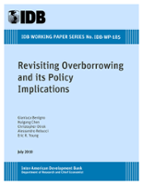Revisiting Overborrowing and Its Policy Implications
Date
Jul 2010
This paper analyzes quantitatively the extent to which there is overborrowing (i.e., inefficient borrowing) in a business cycle model for emerging market economies with production and an occasionally binding credit constraint. The main finding of the analysis is that overborrowing is not a robust feature of this class of model economies: it depends on the structure of the economy and its parametrization. Specifcally, underborrowing in a production economy is found with the baseline calibration, but overborrowing with more impatient agents and more volatile shocks. Endowment economies display overborrowing regardless of parameter values, but they do not allow for policy intervention when the constraint binds (in crisis times). Quantitatively, the welfare gains from implementing the constrained¬effcient allocation are always larger near crisis times than in normal ones. In production economies, they are one order of magnitude larger than in endowment economies both in crisis and normal times. This suggests that the scope for economy¬widemacro¬prudential policy interventions (e.g., prudential taxation of capital flows and capital controls) is weak in this class of models.



